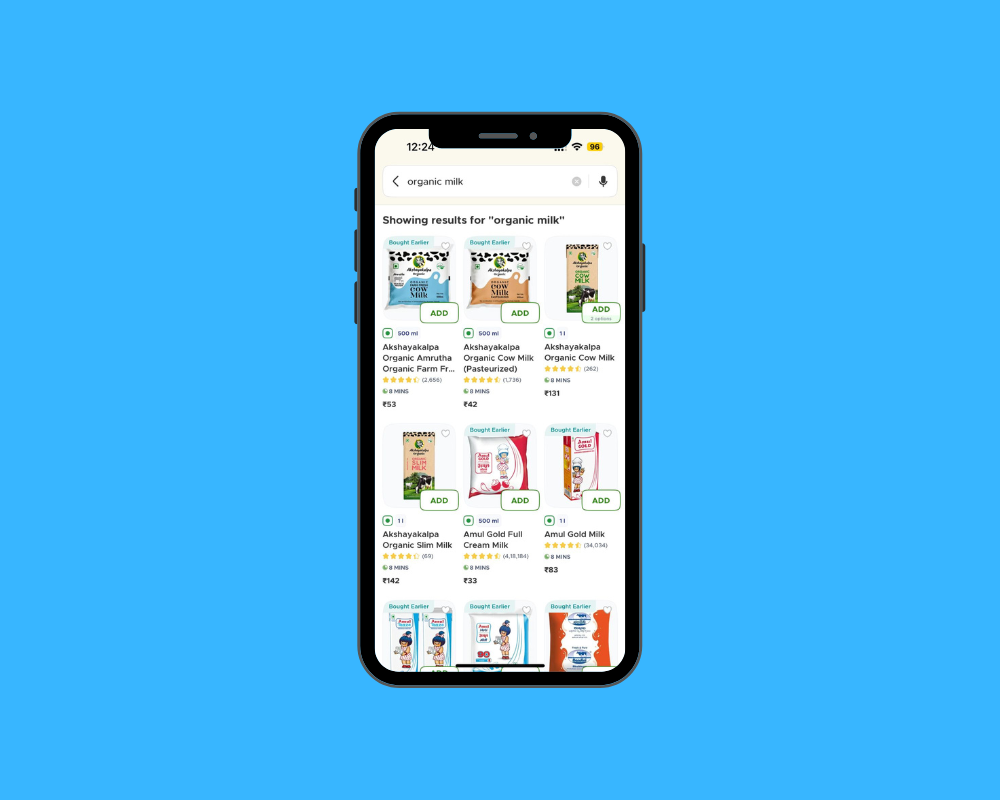In the age of instant gratification, quick commerce isn’t just reshaping buying behavior, it’s rewriting the rules of visibility and competition. For challenger brands, the battleground has moved from distributor-led shelf space to algorithm-led screen space. And in this war for discoverability, legacy brands seem to be winning.
Picture this:
It’s 4:30 PM. A young working professional opens Blinkit, craving a quick drink. She tries “coffee” and sees Nescafé in every format imaginable: sachets, jars, ready-to-drink cold brews. Every variant is placed strategically, matched to mood, occasion, and price sensitivity. This visibility pattern is not incidental. It is a function of intent-driven SKU architecture, algorithmically-optimized metadata, and platform-level performance signals. Legacy brands are leveraging structured assortment strategies and high-frequency engagement data to dominate search result hierarchies, effectively operationalizing q-commerce algorithms to consolidate first-fold real estate.

Legacy brands enter q-commerce with built-in advantages: larger assortments, deeper pockets, and easier to hit availability ratios that fuel visibility algorithms. Challenger brands, by contrast, often operate with a limited SKU lineup, smaller media budgets, and weaker engagement signals, leaving them consistently outbid and under-discovered.
To level the playing field, they need to stop mirroring incumbents and start gaming the system - with precision. For challenger brands, competing with legacy players on sheer assortment volume or media budgets is neither viable nor necessary. The key lies in leveraging algorithmic mechanics to create outsized impact with limited resources. Instead of mirroring SKU sprawl, emerging brands must optimize for intent mapping and hyperlocal performance loops. What follows is a strategic framework tailored for asymmetric shelf warfare, where precision, not scale, becomes the growth multiplier.
1. Micro-Intent Mapping:
Challenger brands shouldn’t compete for generic, high-volume queries—instead, they must own high-intent, long-tail searches aligned with specific user behaviors and needs.
- Avoid generic terms like “chips” where legacy brands dominate.
- Target nuanced queries such as:
- “Protein chips”
- “Healthy evening snack”
- “Guilt-free snack”
- Optimize every listing element:
- Product titles.
- Descriptions: Focus on benefit-led language like “Perfect for post-workout snacking” or “Tiffin-ready, no-fry chips for kids”
- Tags & backend metadata: Include intent-rich tags like “low calorie”, “keto snack”, “school snack”, “high satiety”
- Index against micro-moments: Think "late-night snack", "office munchies", "gym bag essential"—use these in copy and keyword targeting.

2. Geo-Fenced Growth Loops
Instead of spreading thin with a national rollout, challenger brands should go big in hyperlocal markets where they already have strong regional presence. By focusing stock and ad budgets in these zones, they can drive concentrated sales and higher conversion rates. This triggers the platform’s algorithm to boost local visibility—making the product more discoverable in that area. Over time, this creates a self-reinforcing loop where local dominance fuels continued growth.
3. Strategic SKU Architecture
To optimize visibility in a hyper-competitive q-commerce landscape, challenger brands must engineer their SKUs with strategic intent—not merely by offering flavor variations. Each listing should be designed to cater to a specific consumer segment or use-case, ensuring alignment with detailed search intent. For instance:
- “Post-Workout Protein Chips” → Targets fitness-conscious consumers searching for functional snacks.
- “Late-Night Craving Packs” → Indexed for binge-time or comfort food occasions.
- “Tiffin-Safe Mini Packs” → Captures parental searches for school-friendly, portion-controlled snacks.
This intent-driven SKU architecture doesn’t just fragment the product catalog—it maximizes the brand's category adjacency and relevance redundancy. By diversifying SKUs around specific needs, challenger brands capture multiple entry points into search results, effectively expanding their algorithmic surface area and increasing their discoverability across different segments and use cases.
4. Time-Synced Promotion Bursts
Shelf volatility is highest during off-peak hours (e.g., 3 PM – 5 PM, post 10 PM). Use low-competition ad bursts paired with limited-time discounts to artificially elevate SKUs.
Even short-term lifts during slack periods can train the algorithm to re-prioritize listings for future sessions.
Execution Example: The Crav’d Blueprint
Let’s imagine a new entrant, Crav’d, launching in the snack segment. Instead of shadowboxing with Lay’s, Crav’d rolls out three precision-engineered SKUs:
- Sriracha Baked Chips → Mapped to “spicy healthy snacks.”
- Low-Calorie 100 Cal Packs → Optimized for “diet-friendly snacks.”
- After-School Snack Mix → Indexed against “healthy school snacks.”
They geo-lock supplies to NCR, run ad campaigns post-lunch tagged “guilt-free snacking,” and offer a limited-time bundle—“Healthy After School Cravings.”
This would allow Crav’d to potentially gain organic rank for “baked chips” and “low cal snacks”—not by competing on SKU count, but by orchestrating search signals.
Conclusion: Recode the Shelf Before It Codes You Out
Legacy players may dominate the present, but q-commerce has redefined the rules of visibility. The shelf is now volatile, algorithmic, and programmable. Challenger brands must shed traditional playbooks. This is a game of signal engineering, category adjacency, and growth-loop design. To win, think like a search strategist, execute like a D2C growth hacker, and speak to the shelf like it’s a sentient machine—because increasingly, it is.







